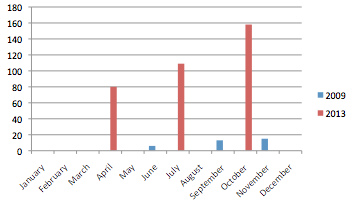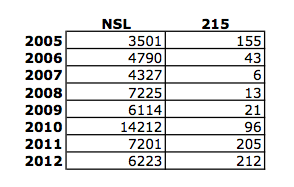John Bates Intervened in the Phone Dragnet Problems
Yesterday, I Con the Record released more records in response to the ACLU FOIA for records on the Section 215 program (though once again, they didn’t mention the FOIA).
Three of the documents provide more data points for a notable progression I laid out in this post, in which Reggie Walton appears to have shut down some collection from one telecom on July 9, 2009, reapproved it (including retroactively) on September 3, 2009, just in time for the Intelligence Community to claim Section 215 collection was central to the Najibullah Zazi investigation.
First, a July 2, 2009 notice to Walton provided the End-to-End review “for the Court’s information.” It had been completed on June 25 and provided to the Intelligence and Judiciary Committees on June 30. It was also included in the formal DOJ filing to Walton on August 19, which left the impression that DOJ had held it for two months before sharing it with the court. But this notice makes it clear Walton received a copy with only a slight delay (and the day before they delivered the first weekly report he had demanded). It also makes it clear he had gotten it, and probably read it, before whatever action he took on July 9. What may be the problematic collection (see page 15-16) apparently got reported to FISC before May 29 (no mention of a formal notice is included, though it seems to be addressed in the May 29 order). But there are other violations (such as the sharing described on page 17 that may involve Homeland Security) that appear to have been newly disclosed with this report.
In a second document — a September 10 notice to just the Senate Intelligence Committee (?!) that Judge Walton had reauthorized the bulk collection program on September 3 — reveals that on August 4, FISC Chief Judge John Bates had written Eric Holder a letter raising concerns. The notice portrays a September 1 demonstration for Walton, Bates, and Judge Thomas Hogan (who I believe was the only other FISC judge from the DC Circuit at the time) apparently at NSA as a response to Bates’ concerns. But the description of the demonstration also notes that,
The information was presented in the context of a current operation that concerns a potential threat to the U.S. homeland.
Remember, this was before (by 2 days) the Zazi investigation started. So this must reference something else, though it certainly didn’t sound all that urgent.
In any case, while it is unclear who got Bates involved (after all, it could have been the Administration, complaining that some of its production had been cut off), it is noteworthy he was involved, which provides a little more background to the frustration he expressed in his October 3, 2011 opinion accusing the government of signifiant misrepresentations on 3 occasions.
Finally, on October 21, in what must have been part of the PATRIOT Act reauthorization push, National Counterterrorism Center’s Michael Leiter and the NSA’s Assistant Deputy Director for Counterterrorism addressed the House Intelligence Committee. Along with their case for the program and a heavily glossed description of the problems with it (which they indicate had already been noticed in some form to the Committee), they described how tips from the dragnet “have contributed directly to the following specific cases,” plural. It includes an entirely unredacted description of the dragnet’s role in the Zazi investigation (without, for example, disclosing FBI already knew of Adis Medunjanin through travel documents to Pakistan where he and Zazi trained with terrorists). And it includes a shorter description of what must be at least one other case, which is entirely redacted. It’s possible, after all, that that second “success” (which is so credible we can’t know about it) is the ongoing threat referred to in the September 10 notice, which NSA used to scare FISC into reauthorizing the dragnet.
One more detail about the notice to HPSCI. It fails to mention that, less than 3 weeks after he reauthorized the dragnet, Walton learned — from DOJ, not NSA — of further information sharing violations. In other words, the HPSCI witnesses falsely portrayed the problems as fixed, when there were pending violations still being discussed between NSA and FISC.
There’s nothing enormous in these revelations, but they do add to the understanding of how grave FISC took these violations to be, and how partial was Congressional briefing on them. Read more →


